maintenance LINCOLN CONTINENTAL 1996 Customer Assistance Guide
[x] Cancel search | Manufacturer: LINCOLN, Model Year: 1996, Model line: CONTINENTAL, Model: LINCOLN CONTINENTAL 1996Pages: 320, PDF Size: 1.8 MB
Page 245 of 320

Fuel Economy
Fuel economy is an estimate of the efficiency of
your vehicle and can be calculated as Miles Per
Gallon (MPG) or liters Per 100 Kilometers (L/
100K).
Do not calculate fuel economy during your vehicle's
break-in period. This would not be an accurate
estimate of how much fuel your vehicle will
normally use.
Tocalculate fuel economy:
I .Fill the tank completely and record the initial
odometer reading.
2.Every time you buy fuel record the amount (in
gallons or liters) purchased.
3.After at least three to five tankfuls, fill the fuel
tank and record the final odometer reading.
4. Use these equations to calculate your fuel
economy. English: MPG = (total miles)/(gallons used). Metric: L/100K = (liters used) x 100/(total
kilometers)
Comparisons With EPA Fuel Economy
Estimates
EPA fuel economy figures are obtained from
laboratory tests under simulated road conditions and
may not reflect the actual conditions you experience
or your style of driving. The EPA fuel economy
estimate is not a guarantee that you will achieve the
fuel economy shown.
The following decrease fuel economy: Lack of regular, scheduled maintenance Rapid acceleration and excessive speed Driving with your foot on the brake Sudden stops Extended engine idling
243
Page 246 of 320

Using speed control in hilly terrain Extended use of the A/C, defroster, rear window
defroster and other accessories Underinflated tires Heavy loads Aftermarket add-ons such as bike, ski or luggage
racks, bug deflectors, etc.
Self-Service Pointers
If you choose to do your own fueling, you should
also perform a few simple maintenance routines.
This extra effort will save you additional money and
contribute to the driving efficiency of your vehicle.
The following procedures require only a tire gauge,
a rag, an oil can spout and windshield washer fluid.Check the engine oil at every refueling stopClean the windshield, outside mirrors and
headlights
244 Check windshield washer fluid Check tires for excessive wear or worn edges Check the tire pressure at least monthly
Engine Oil Recommendations
We recommend using Motorcraft oil or an equivalent
oil meeting Ford Specification ESE-M2C153-E and
displaying the American Petroleum Institute
CERTIFICATION MARK on the front of the
container.
Page 247 of 320
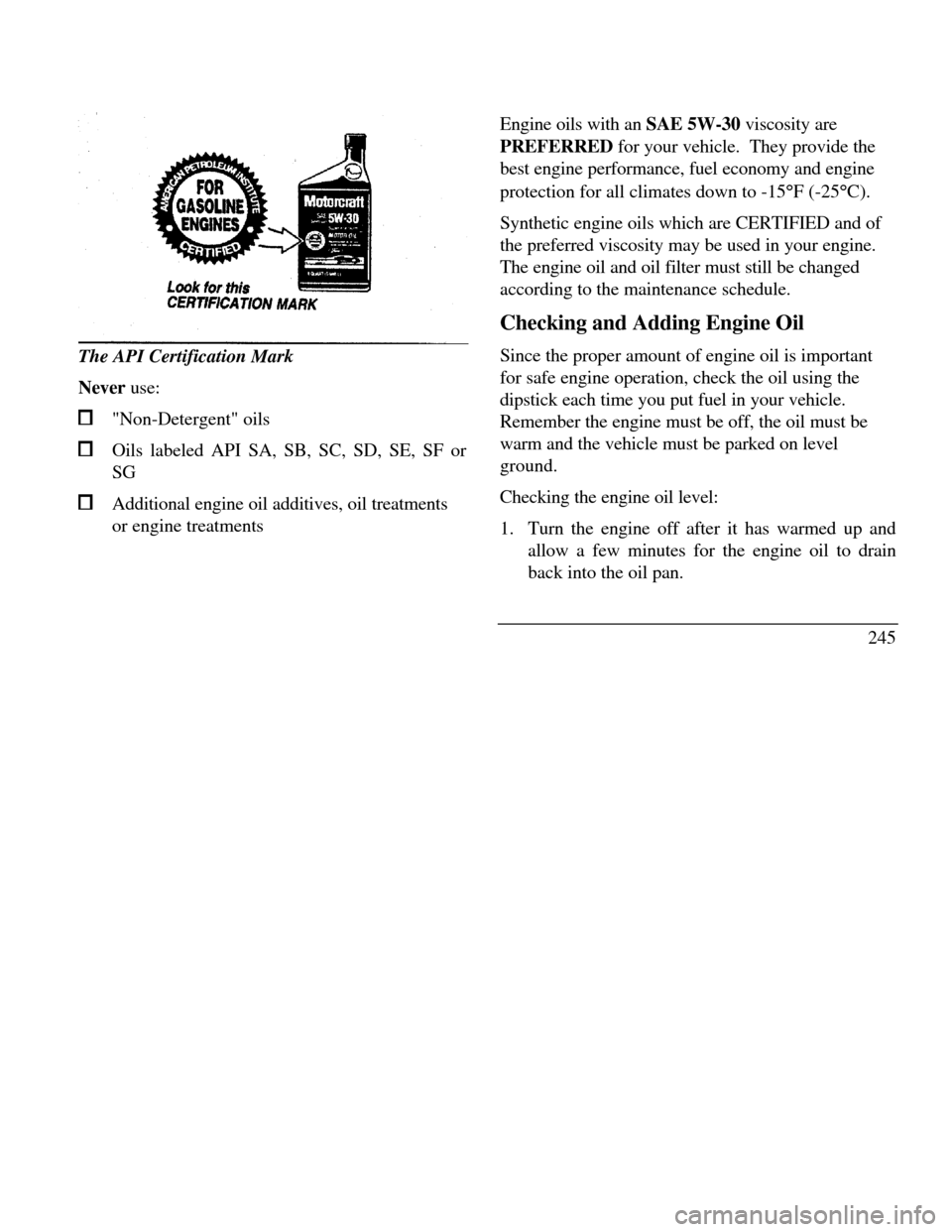
The API Certification Mark
Never use:"Non-Detergent" oilsOils labeled API SA, SB, SC, SD, SE, SF or
SGAdditional engine oil additives, oil treatments
or engine treatmentsEngine oils with an SAE 5W-30 viscosity are
PREFERRED for your vehicle. They provide the
best engine performance, fuel economy and engine
protection for all climates down to -15°F (-25°C).
Synthetic engine oils which are CERTIFIED and of
the preferred viscosity may be used in your engine.
The engine oil and oil filter must still be changed
according to the maintenance schedule.
Checking and Adding Engine Oil
Since the proper amount of engine oil is important
for safe engine operation, check the oil using the
dipstick each time you put fuel in your vehicle.
Remember the engine must be off, the oil must be
warm and the vehicle must be parked on level
ground.
Checking the engine oil level:
1. Turn the engine off after it has warmed up and
allow a few minutes for the engine oil to drain
back into the oil pan.
245
Page 249 of 320
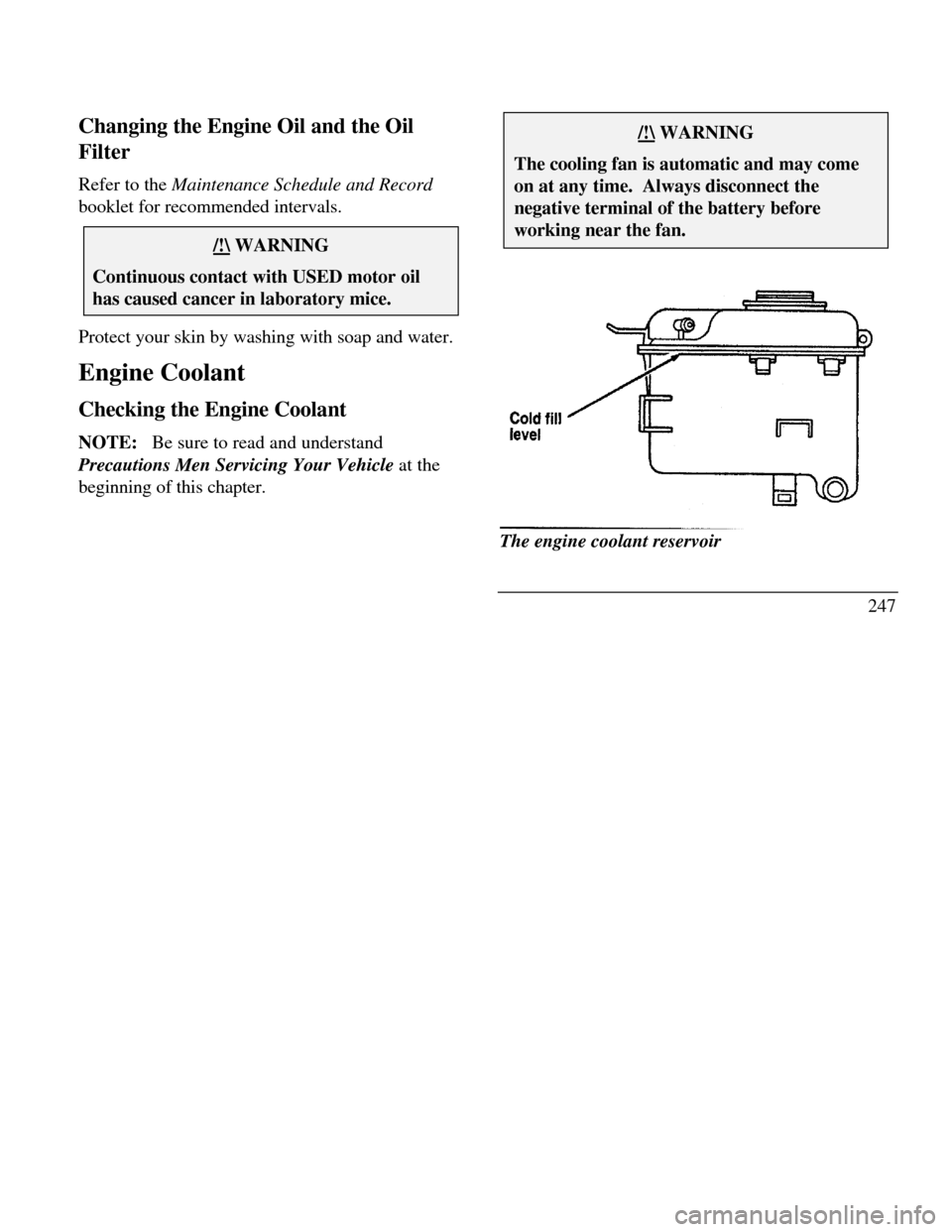
Changing the Engine Oil and the Oil
Filter
Refer to the Maintenance Schedule and Record
booklet for recommended intervals./!\ WARNINGContinuous contact with USED motor oilhas caused cancer in laboratory mice.Protect your skin by washing with soap and water.
Engine Coolant
Checking the Engine Coolant
NOTE: Be sure to read and understand
Precautions Men Servicing Your Vehicle at the
beginning of this chapter./!\ WARNINGThe cooling fan is automatic and may comeon at any time. Always disconnect thenegative terminal of the battery beforeworking near the fan.Cold fill levelThe engine coolant reservoir
247
Page 250 of 320
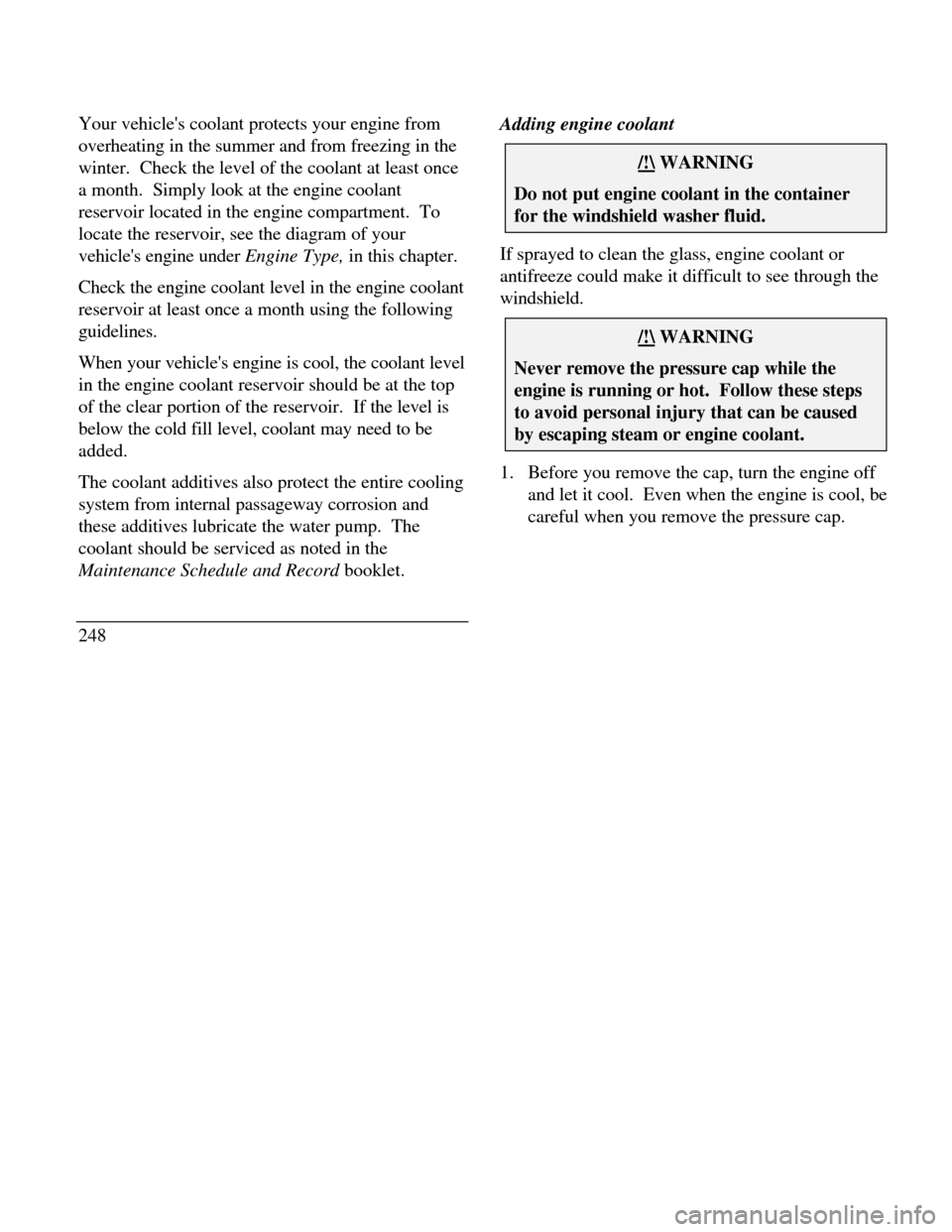
Your vehicle's coolant protects your engine from
overheating in the summer and from freezing in the
winter. Check the level of the coolant at least once
a month. Simply look at the engine coolant
reservoir located in the engine compartment. To
locate the reservoir, see the diagram of your
vehicle's engine under Engine Type, in this chapter.
Check the engine coolant level in the engine coolant
reservoir at least once a month using the following
guidelines.
When your vehicle's engine is cool, the coolant level
in the engine coolant reservoir should be at the top
of the clear portion of the reservoir. If the level is
below the cold fill level, coolant may need to be
added.
The coolant additives also protect the entire cooling
system from internal passageway corrosion and
these additives lubricate the water pump. The
coolant should be serviced as noted in the
Maintenance Schedule and Record booklet.
248Adding engine coolant/!\ WARNINGDo not put engine coolant in the containerfor the windshield washer fluid.If sprayed to clean the glass, engine coolant or
antifreeze could make it difficult to see through the
windshield./!\ WARNINGNever remove the pressure cap while theengine is running or hot. Follow these stepsto avoid personal injury that can be causedby escaping steam or engine coolant.1. Before you remove the cap, turn the engine off
and let it cool. Even when the engine is cool, be
careful when you remove the pressure cap.
Page 254 of 320

Select maximum heater temperature and fan
speed settings. Position control to discharge air
at A/C vents in instrument panel. Start engine and allow to idle. While engine is
idling, feel for hot air at A/C vents.
NOTE: IF AIR DISCHARGE REMAINS COOL
AND ENGINE TEMPERATURE GAUGE DOES
NOT MOVE, SHUT ENGINE OFF
IMMEDIATELY. This is an indication of low
coolant level and/or air pockets in coolant system.
Allow engine to cool and repeat the previous steps. Allow to idle until normal operating temperature
is reached. Hot air should discharge from A/C
vents. The engine temperature gauge should
maintain a stabilized reading in the middle of the
"NORMAL" range and the lower radiator hose
should feel hot to the touch. Shut off the engine and allow to cool down.
252 After the engine cools down, recheck the engine
coolant level. Fill reservoir to the COLD-FULL
level as required.Check for leaks at the draincock, block plug and
vent plug.Recheck the engine coolant level, using the
recommended procedure, after one or two
occasions of vehicle use. Fill to COLD-FULL
level as required.
Battery
Your vehicle may have a Motorcraft maintenance-
free battery. When the original equipment battery is
replaced under warranty it may be replaced by a low-
maintenance battery. See Motorcraft Parts at the
end of this chapter for the proper replacement
battery.
Page 255 of 320

The low-maintenance battery has removable vent
caps for checking the electrolyte level and adding
water. The electrolyte level should be checked at
least every 24 months or 24,000 miles (40,000 km)
in temperatures up to 90'F (32'C) and more often in
temperatures above 90'F (32'C). Keep the
electrolyte level in each cell up to the level
indicator. Do not overfill.
If the level gets low, refill the battery with distilled
water. If necessary, you can add tap water to the
battery, provided the water is not hard or does not
have a high mineral or alkali content. If the battery
needs water quite often, have the charging system
checked for a possible malfunction.
Help Us Protect Our Environment
Ford Motor Company strongly recommends that
used lead-acid batteries be returned to an authorized
recycling facility for disposal.Battery recycling symbol
Because your vehicle's engine is electronically
controlled by a computer, some control conditions
are maintained by power from the battery. If you
ever disconnect the battery or install a new battery,
you must allow the computer to "relearn" its idle
conditions before your vehicle will drive properly.
To let the engine do this, put the gearshift in P
(Park), turn off all the accessories, and start the
vehicle. Let the engine idle for at least one minute.
(Engine must be warm in order to "learn.") Also,
allow approximately 10 miles (16 km) of stop and go
traffic for your vehicle's engine to completely
girelearn" its idle.
253
Page 259 of 320
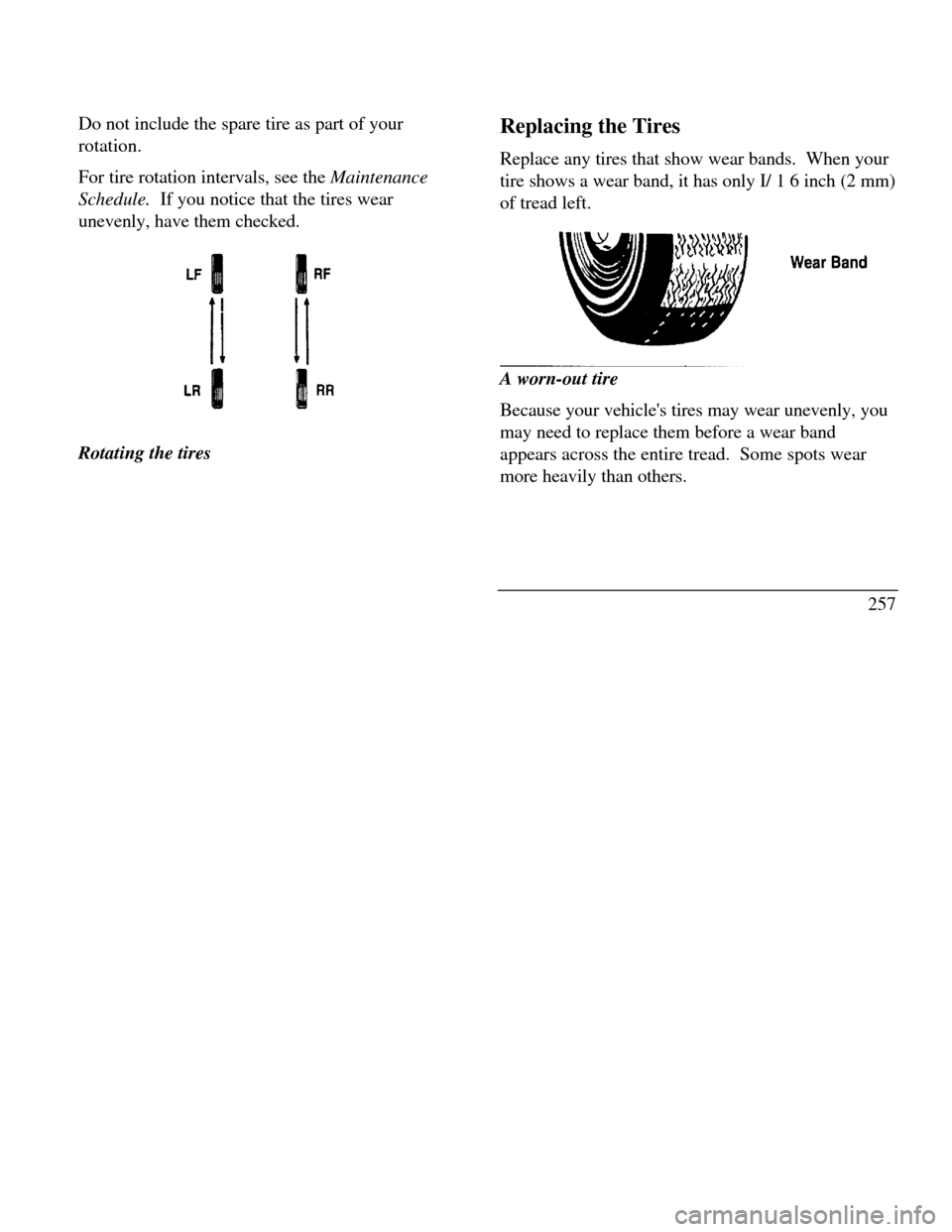
Do not include the spare tire as part of your
rotation.
For tire rotation intervals, see the Maintenance
Schedule. If you notice that the tires wear
unevenly, have them checked.Rotating the tiresReplacing the Tires
Replace any tires that show wear bands. When your
tire shows a wear band, it has only I/ 1 6 inch (2 mm)
of tread left.A worn-out tire Wear Band
Because your vehicle's tires may wear unevenly, you
may need to replace them before a wear band
appears across the entire tread. Some spots wear
more heavily than others.
257
Page 263 of 320

See Securitires in the Features chapter for more
information.
Automatic Transaxle Fluid
Under normal circumstances, you do not need to
check the fluid level of the transaxle, since your
vehicle does not use up transaxle fluid. Refer to the
Maintenance Schedule and Record booklet for
replacement intervals. However, if the transaxle is
not working properly - for instance, the transaxle
may slip or shift slowly, or you may notice some
sign of fluid leakage - the fluid level should be
checked.
NOTE: If the vehicle has been operated for an
extended period at high speeds or in city traffic
during hot weather, or pulling a trailer, the vehicle
should be turned off for about 30 minutes to allow
the fluid to cool before checking.Checking the Automatic Transaxle Fluid
With the vehicle on a level surface and the brake fully
applied, start the engine and move the gear shift
selector through all of the gears allowing sufficient
time for each position to engage. Securely latch the
gear shift selector in the P (Park) position. Fully set
the parking brake and leave the engine running.
Wipe off the dipstick cap and pull the dipstick out.
Wipe the indicator end clean. Put the dipstick back
into the filler tube and make sure it is fully seated.
Pull the dipstick out and read the fluid level.
NOTE: Your vehicle should not be driven until
some fluid has been added if the fluid level is below
the bottom dimple on the dipstick and the outside
temperature is above 50°F (10°C). Add only enough
fluid to bring the level above the bottom hole.
261
Page 286 of 320
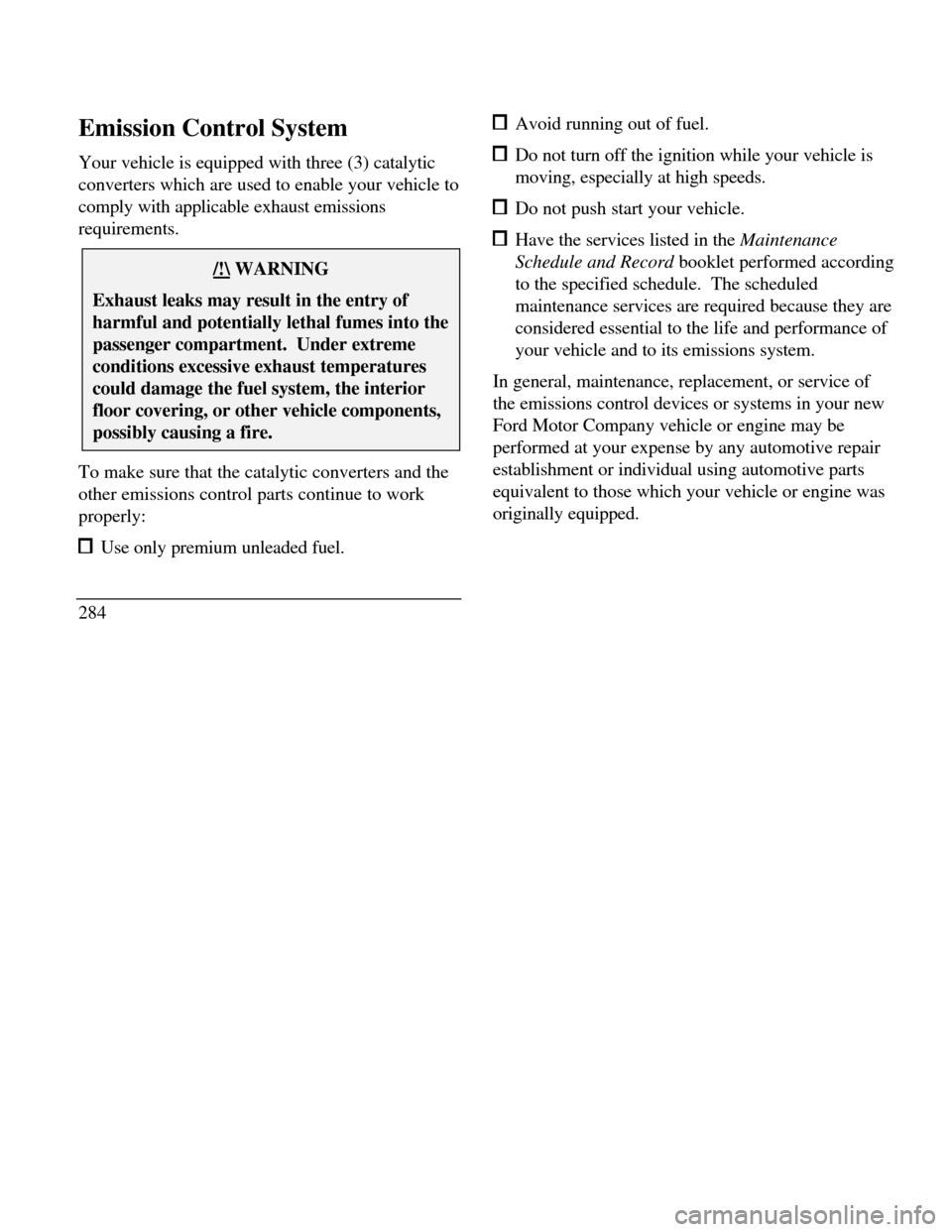
Emission Control System
Your vehicle is equipped with three (3) catalytic
converters which are used to enable your vehicle to
comply with applicable exhaust emissions
requirements./!\ WARNINGExhaust leaks may result in the entry ofharmful and potentially lethal fumes into thepassenger compartment. Under extremeconditions excessive exhaust temperaturescould damage the fuel system, the interiorfloor covering, or other vehicle components,possibly causing a fire.To make sure that the catalytic converters and the
other emissions control parts continue to work
properly: Use only premium unleaded fuel.
284 Avoid running out of fuel. Do not turn off the ignition while your vehicle is
moving, especially at high speeds. Do not push start your vehicle. Have the services listed in the Maintenance
Schedule and Record booklet performed according
to the specified schedule. The scheduled
maintenance services are required because they are
considered essential to the life and performance of
your vehicle and to its emissions system.
In general, maintenance, replacement, or service of
the emissions control devices or systems in your new
Ford Motor Company vehicle or engine may be
performed at your expense by any automotive repair
establishment or individual using automotive parts
equivalent to those which your vehicle or engine was
originally equipped.